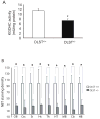Mice deficient in dihydrolipoyl succinyl transferase show increased vulnerability to mitochondrial toxins
- PMID: 19660549
- PMCID: PMC3605719
- DOI: 10.1016/j.nbd.2009.07.023
Mice deficient in dihydrolipoyl succinyl transferase show increased vulnerability to mitochondrial toxins
Abstract
The activity of a key mitochondrial tricarboxylic acid cycle enzyme, alpha-ketoglutarate dehydrogenase complex (KGDHC), declines in many neurodegenerative diseases. KGDHC consists of three subunits. The dihydrolipoyl succinyl transferase (DLST) component is unique to KGDHC. DLST(+/-) mice showed reduced mRNA and protein levels and decreased brain mitochondrial KGDHC activity. Neurotoxic effects of mitochondrial toxins were exacerbated in DLST(+/-) mice. MPTP produced a significantly greater reduction of striatal dopamine and tyrosine hydroxylase-positive neurons in the substantia nigra pars compacta of DLST(+/-) mice. DLST deficiency enhanced the severity of lipid peroxidation in the substantia nigra after MPTP treatment. Striatal lesions induced by either malonate or 3-nitropropionic acid (3-NP) were significantly larger in DLST(+/-) mice than in wildtype controls. DLST deficiency enhanced the 3-NP inhibition of mitochondria enzymes, and 3-NP induced protein and DNA oxidations. These observations support the hypothesis that reductions in KGDHC may impair the adaptability of the brain and contribute to the pathogenesis of neurodegenerative diseases.
Figures







References
-
- Beal MF, Brouillet E, Jenkins B, Henshaw R, Rosen B, Hyman BT. Age-dependent striatal excitotoxic lesions produced by the endogenous mitochondrial inhibitor malonate. J Neurochem. 1993a;61:1147–1150. - PubMed
-
- Beal MF, Ferrante RJ, Henshaw R, Matthews RT, Chan PH, Kowall NW, Epstein CJ, Schulz JB. 3-Nitropropionic acid neurotoxicity is attenuated in copper/zinc superoxide dismutase transgenic mice. J Neurochem. 1995;65:919–922. - PubMed
Publication types
MeSH terms
Substances
Grants and funding
LinkOut - more resources
Full Text Sources
Molecular Biology Databases
Miscellaneous

